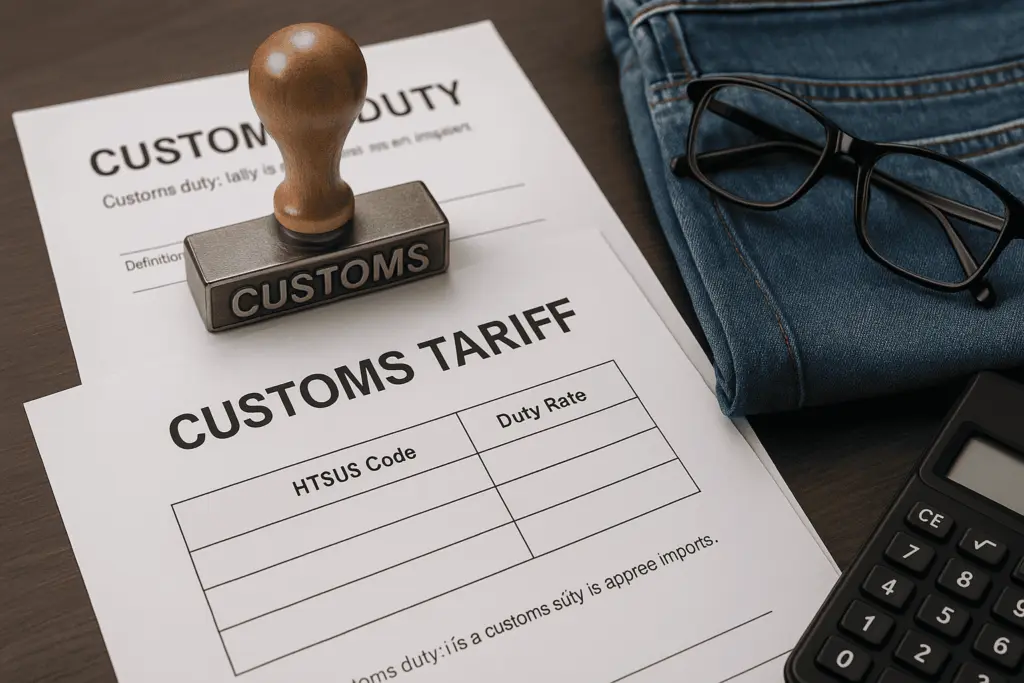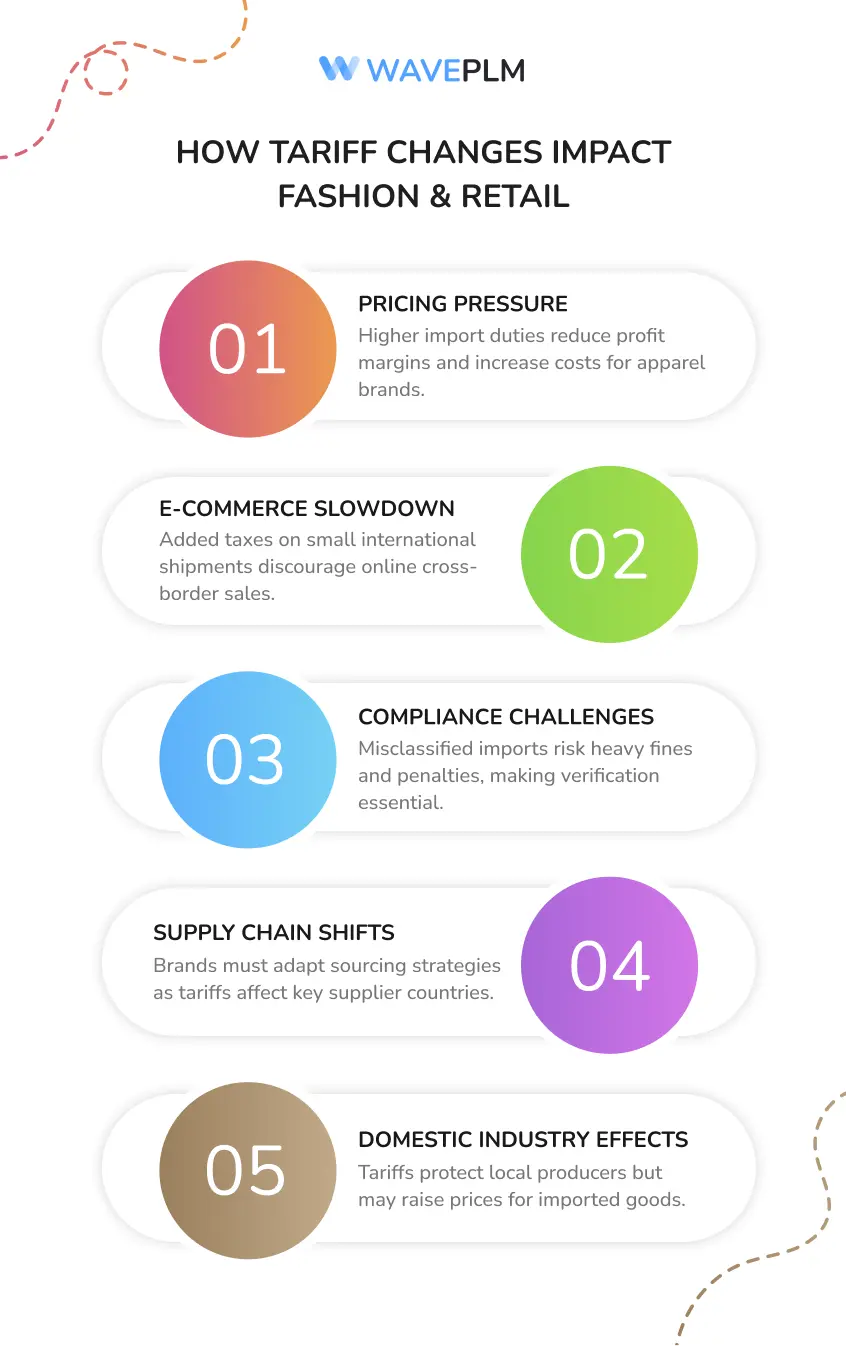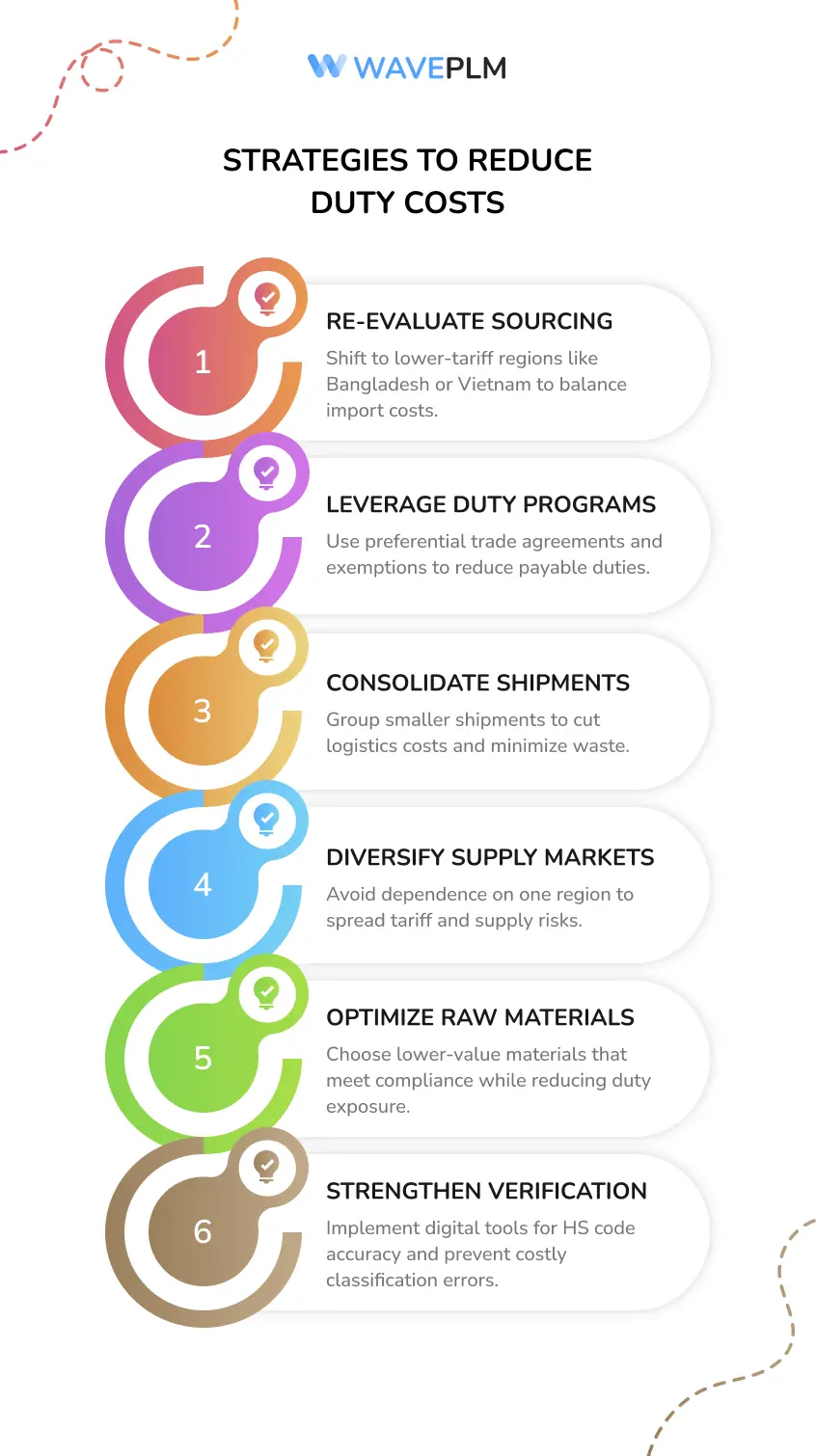
Introduction
Fashion brands preparing for the U.S. market in 2025 face one of the most complex regulatory landscapes in decades. Customs duty, basic customs duty, and anti-dumping duty all play central roles in shaping how imports move through supply chains. Recent changes to import duties, such as the removal of the de minimis threshold and reciprocal tariffs with China, mean businesses cannot ignore these costs.
The U.S. has also adjusted tariffs under its agreements with the EU, adding another layer of complexity. India’s increasing share of apparel exports further impacts how brands plan sourcing strategies. To stay competitive, businesses need clear strategies, robust compliance, and integration of customs planning into PLM systems.
Understanding Key Terms: Customs Duty, Basic Customs Duty & Anti-Dumping
What is Customs Duty?
Customs duty is a tax levied on imported goods. In apparel, it applies to garments, textiles, footwear, raw hides, and travel goods. Customs duty is an indirect tax imposed by the government to regulate imports and generate revenue. For apparel imports, the rate depends on HS code classification, the country of origin, and trade agreements. Taxes are levied on the assessable value of goods imported, which includes production costs, freight, and insurance.
What is Basic Customs Duty?
Basic customs duty is the standard rate listed under the Harmonized Tariff Schedule of the United States (HTSUS). These ad valorem charges reflect average tariff rates applied to apparel imports. Basic customs duty can differ depending on whether apparel qualifies under special trade agreements such as the Opportunity Act. Apparel importers must calculate duty on the declared assessable value, making compliance critical.
What is Anti-Dumping Duty?
Anti-dumping duty is imposed when exporters sell apparel imports below fair market value. This measure protects domestic industries, such as textiles and footwear, from unfair competition. For example, apparel imports from China or India could face anti dumping duty if proven to undercut U.S. production. These duties aim to keep domestic industries healthy and balance trade with other countries.
Major Recent Policy Changes in U.S. Import Duties (2025)
|
Policy Change |
Impact on Fashion |
Source |
|
Removal of de minimis threshold |
All shipments, even low-value apparel, now face import taxes and duties—a factor consumers consider when choosing high-quality clothing. |
India Briefing, DHL |
|
Reciprocal tariff adjustments with China |
Higher tariffs imposed on apparel imports from China |
Shenglu Fashion |
|
EU-US framework deal |
Tariff adjustments on apparel imports from the EU |
World Collective Ecosystem |
The removal of the de minimis exemption means every shipment is taxed. This change particularly impacts e-commerce, where brands relied on small, duty-free shipments. Reciprocal tariffs with China raise average tariff rates, increasing landed cost. The EU-U.S. framework modifies tariff rates on textiles, footwear, and travel goods. Imports from India continue to grow, with Indian textiles and garments playing a significant role in U.S. supply chains. While India is not directly targeted with higher tariffs, the country must navigate evolving U.S. trade policy to maintain its strong export position.
How These Tariff Changes Affect Fashion Brands & Retailers
- Pricing & Profit Margins: Duties increase costs for apparel imports from India, Bangladesh, and Vietnam. Higher tariffs reduce profit margins unless businesses raise prices or cut other expenses.
- International E-commerce: Import duties now apply to small shipments. Consumers face higher taxes, increasing the risk of abandoned carts and slower cross-border commerce.
- Compliance Risks: Misclassifying goods imported under the wrong hs code leads to penalties, fines, or higher duty payments. Verification is crucial.
- Impact on Supply Chains: Supply chains dependent on imports must adjust sourcing. Brands consider suppliers in countries with lower average tariff rates. India’s role is vital, as U.S. fashion companies rely heavily on Indian textiles, raw materials, and finished garments.
- Tariff Burden for Industry: Domestic industries in the U.S. expect protection from anti dumping duties, which can result in higher tariffs for imports from India and China. This balance between protecting local industry and ensuring affordable imports remains a subject of debate.

How to Stay Informed & Compliant
To manage risk, apparel importers must:
- Check the HTSUS: Use the Harmonized System Nomenclature on hts.usitc.gov to verify tariff rates.
- Monitor Announcements: Follow updates from U.S. Customs, the central board, and the U.S. Trade Representative.
- Consult Experts: Work with customs brokers, importers, and trade specialists to ensure classification and payment compliance.
- Prepare for Payment: Plan early for customs duty, basic customs duty, and additional indirect taxes like services tax and integrated GST.
- Watch Indian Trade Policy: India’s government supports exporters through subsidies and incentives, influencing how competitive Indian apparel remains in the U.S. market.
Integrating Customs Duty Planning into PLM Workflows
PLM software enables fashion brands to prepare for customs tariff fashion planning by embedding duty data into product development.
|
PLM Feature |
Benefit for Apparel Imports |
|
HS Code Storage |
Assign accurate HS code to each SKU |
|
Landed Cost Simulation |
Calculate landed costs with customs duty, import duties, freight, services tax, and integrated GST |
|
Regulation Tracking |
Automated alerts for tariff hikes, higher tariffs, or changes affecting apparel imports |
|
Supplier Comparison |
Analyze sourcing options across India, Vietnam, Bangladesh, and Brazil |
|
Documentation Verification |
Ensure compliance with paperwork, reducing delays at customs checkpoints |
By adding customs duty planning into PLM, businesses account for tariff rates early, avoid surprises in landed cost, and maintain compliance across supply chains.
Strategies for Brands to Mitigate Duty Costs
- Re-evaluate Sourcing: Shift to suppliers in Bangladesh, Vietnam, or Brazil where tariff rates may be lower than India or China.
- Use Preferential Programs: Leverage exemptions under the Opportunity Act or special programs that reduce duty rates on apparel imports.
- Consolidate Shipments: Cut waste and logistics costs by grouping shipments into larger units instead of frequent small shipments.
- Diversify Markets: Avoid overreliance on one country. Balance between India, Vietnam, and other suppliers to manage risks.
- Focus on Raw Materials: Choose fabrics, scrap, or raw hides that lower assessable value while complying with rules.
- Invest in Verification: Use technology to ensure HS code classification accuracy, minimizing fines and unexpected duties.

Why This Matters for Wave PLM Readers
Fashion businesses must address customs duty, basic customs duty, and anti dumping duty as part of strategic planning. By embedding tariff rates and taxes into PLM workflows, brands gain accurate cost visibility, smoother supply, and stronger compliance. India’s expanding apparel exports mean U.S. brands must carefully evaluate sourcing. With tariffs rising globally, from rare earth metals to tobacco, the fashion industry remains vulnerable to trade shifts. PLM systems allow businesses to manage these variables effectively, ensuring they stay competitive.
Conclusion
In 2025, apparel imports face greater scrutiny than ever. Customs duties, basic customs duty, and anti dumping duty continue to reshape U.S. trade policy. The removal of the de minimis exemption, reciprocal tariffs with China, tariff changes with the EU, and India’s strong role in textiles redefine cost structures. Businesses that account for average tariff rates, stay informed through government updates, and integrate duty planning into PLM will remain resilient. Those who fail to prepare risk paying higher taxes, facing penalties, and losing competitiveness.
Quick Reference Table: Fashion Customs Duty Essentials (2025)
|
Term |
Meaning |
Impact on Apparel Imports |
|
Customs Duty |
Tax levied on imported goods |
Raises landed cost of apparel |
|
Basic Customs Duty |
MFN rate under HTSUS |
Sets average tariff rates |
|
Anti-Dumping Duty |
Duty imposed on unfair pricing |
Protects domestic industries |
|
De Minimis Removal |
All shipments taxed |
Increases e-commerce costs |
|
HS Code |
Classification system |
Determines tariff rates |
|
Services Tax |
Indirect tax on services |
Adds to total cost |
|
Precious Metals |
Tariff category |
Higher duties for jewelry and accessories |
|
Raw Hides |
Classified under HS codes |
Affects footwear and leather imports |
|
India’s Role |
Major exporter |
Directly influences U.S. apparel imports |
|
Tariff Hike |
Government policy increase |
Raises tariff burden for importers |
Current Customs Duties by Country (2025)
|
Country |
Average Apparel Duty Rate |
Notable Policies or Updates |
Source |
|
United States |
5% – 20% |
Tariff rates vary by HTSUS code; de minimis removal applies to all imports. |
USTR |
|
China |
10% – 25% |
Subject to reciprocal tariff adjustments and higher anti-dumping scrutiny. |
|
|
Vietnam |
7% – 15% |
Benefits from multiple trade agreements reducing effective rates. |
Vietnam Trade Portal |
|
Bangladesh |
12% – 18% |
Competitive labor costs; faces moderate customs duty and documentation requirements. |
Bangladesh Customs |
|
European Union |
6% – 12% |
Lower tariffs under EU-U.S. framework deal; high compliance standards. |
European Commission |
|
Brazil |
10% – 20% |
Import duties influenced by bilateral trade policies. |
Brazil Customs Authority |
|
India |
10% – 25% |
High customs duties apply; strong exporter to U.S. market with ongoing negotiations for preferential rates. |
By understanding customs duty policies, tariff burden, indirect taxes, and India’s growing role in apparel trade, brands can prepare for 2025. PLM integration ensures compliance, reduces risks, and helps fashion businesses stay competitive in an evolving global market.





Leave a Reply